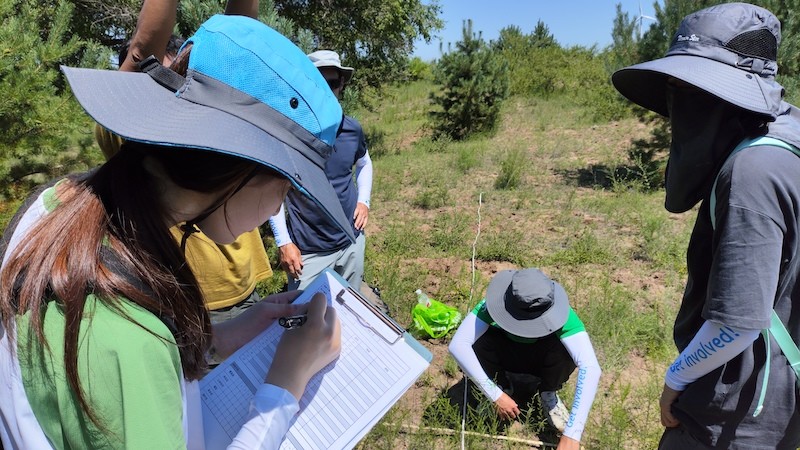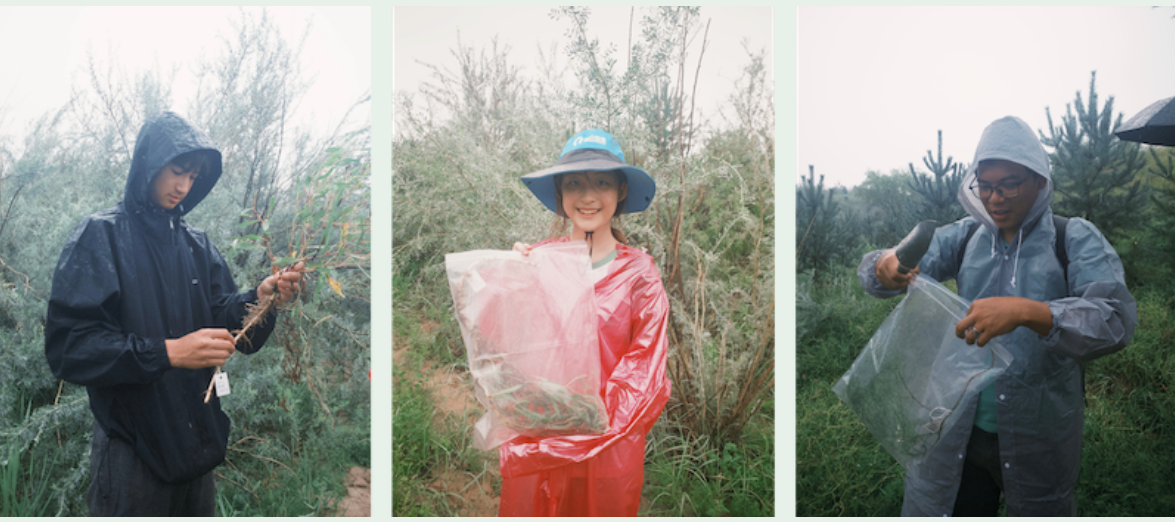From July 19 to 26, 2025, eight volunteers joined the Million Tree Project team in Horqin Left Rear Banner, Tongliao City, Inner Mongolia, to carry out the MTP forest ecological survey. Over the course of six days—under the scorching sun and through heavy rain—the volunteers gained valuable experience.

Volunteers walking in the tree rows, photo by Jiayuan Guo
Each day began with several kilometers of hiking across sandy land. We walked through countless rows of trees to locate markers of the survey plots. Once we found a plot, we used 1m x 1m sampling frames to collect important data on local plant species diversity and vegetation structure.

Volunteers are identifying and counting different plants, photo by Jiayuan Guo

Volunteers are identifying and counting different plants, photo by Jiayuan Guo

Volunteers with their shadows, photo by Kai Wang

Volunteers are counting the plants in the sample square, photo by Jiayuan Guo
At the end of the day, the volunteers would walk along the roads beside the forest. Under the blazing sun, everyone’s shadows stretched long behind them, as if each shadow wanted to tell a story. Let us now delve deeper into the Inner Mongolia ecological survey trip through the words of our volunteers:

Volunteers are collecting plant samples in the rain, photo by Yuzhu Li
“Over these past couple of weeks, I’ve endured intense sun and heavy rain, walking through forests of different planting years and restoration stages with various teammates. I’ve studied soil structure, measured tree growth, recorded vegetation structure, identified and counted different plants, created plant specimens, and sanding tree cores.…
Over the nearly 20-year history of the Million Tree Project, many people have quietly contributed. When I saw how lush and thriving the 2019 forest plots had become, I was genuinely moved by the power of nature. Seeing over ten plant species and hundreds of individual plants within a single 1m x 1m plot made me realize how much I had underestimated the biodiversity of sandy land. Through field measurements and direct observation, I gained a clear understanding of how planting density and species selection affect the long-term sustainable development of shelterbelt.”
—Yuanfan, Volunteer

The 2017 Forest. The left photo was taken on May 10, 2017, and the right was taken on July 245
I was amazed by the dramatic transformation of the project sites. The areas we visited had once been barren and dry but were now full of life. They were covered in trees, native grasses, and signs of budding ecosystems. Comparing before-and-after photos made the impact of the Million Trees Project very clear. We spent our days collecting plant samples, identifying species, and calculating the population density of the fauna present in our sample areas. Based on our research, the results of the reforestation work were incredibly encouraging.
This experience strengthened my passion for environmental conservation. I was pleasantly surprised by how interesting I found the plant research—especially learning about how different types of plant life support healthy ecosystems. I also came away with a better understanding of what makes a conservation project succeed: not just planting trees, but following up, adapting, and working as a team. While I’m still exploring what path I want to take in the future, I know that this trip was a meaningful step toward making a positive impact, and I’m grateful I had the chance to be part of it.
— LI JING, Volunteer
Special thanks to all the volunteers!

The group photo, photo by Kai Wang
